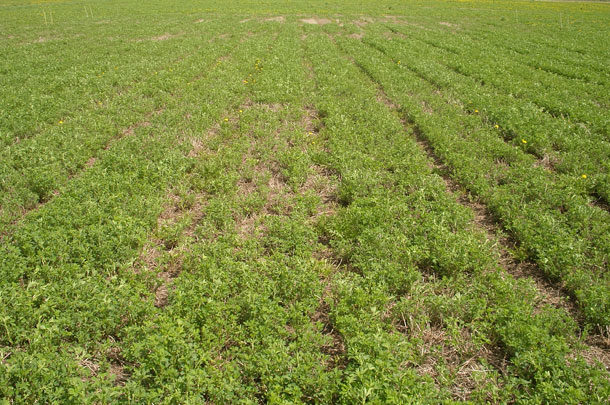1. Decreasing yield
Decreasing yield is the best and most obvious indicator that all is not right in your alfalfa field.
“Some farmers would record the weight of bales off of a field and they could tell that a stand is starting to decline,” says Dan Undersander, head of the forage research extension with the University of Wisconsin – Madison. “Some farmers would record the weight of chopped forage for silos off of fields, and if you follow a field over time and it starts to decline, then that’s the time to take it out. That’s the truest and final test.”
According to Undersander, yield data can be helpful to farmers beyond simply recording yield. Yield data can also provide benchmarks for producers and possibly indicate how different fields might be improved.
Steady decline over a number of years is to be expected with any crop, but experiencing drastic drops in your yield is another indicator. “Anytime your yield drops more than 10 percent, you really need to think about rotation,” says Glenn Shewmaker, extension forage specialist with the University of Idaho.
2. Stand density
Another sign an alfalfa stand is declining is the decrease in stand density. According to Undersander, one of the best ways to estimate yield is to count the number of stems per square foot.
The optimum number recommended by the University of Wisconsin – Madison is 55 stems per square foot. The easiest way to tell is counting the cut stems directly after harvesting. Undersander suggests counting 1 or 2 square feet in different parts of the field to help get an idea of what would be expected, then doing a visual assessment for the rest of the field.
3. Weed pressure
Another indication of stand decline is an increase in weed pressure. “If we have a good, thick stand, if we have an aggressively growing field, it will generally keep the weeds down,” Undersander says. “When the weeds start to come in, that means an older, thinner, less actively growing stand.”
Undersander says that for farmers harvesting their own alfalfa, it is generally not worthwhile to put an herbicide on after the stand has become established because when an herbicide is applied to a weedy field, it may get rid of the weeds, but yield will not increase; it will merely be an additional cost of herbicide.
4. Uniformity of the field
According to Undersander, another sign of a waning stand is the uniformity (or lack thereof) in a field. He says checking uniformity can be done quickly from a pickup cab by checking the field and considering the percentage of good stand versus unprofitable stand.
5. Pests and disease
Another sign your alfalfa stand needs to go is if you have high levels of pests or disease in your stand. “If you have a problem with rodents or any kind of issue that’s difficult to control, that’s going to affect your stand as well,” Shewmaker says. As for insects or diseases that get into the soil, “Once it’s there and in the soil, the damage is just going to increase. That may be a time, if you do a good scouting job, to decide that it’s time,” he says.
Shewmaker says stands of alfalfa can last as long as 20 years, depending on the growing conditions and amount of cutting, but even in highly productive land, there are good reasons to rotate it frequently.
“If you’ve been cutting every 28 days during the summer on a vegetative or pre-bud stage, each cutting, for four to six cuttings, you’re only going to get a couple years of good production out of that,” Shewmaker says. “There are a lot of things that affect the health of the stand and the health of the individual plants in the stand.”
Taking individual conditions into consideration when contemplating crop rotation is always important, but paying attention to what your fields are telling you could save valuable time and money in the long run. ![]()
PHOTO: If you see that your stand is starting to thin out and your yield is decreasing, it’s time to start thinking about rotation. Photo provided by Daniel Undersander.










